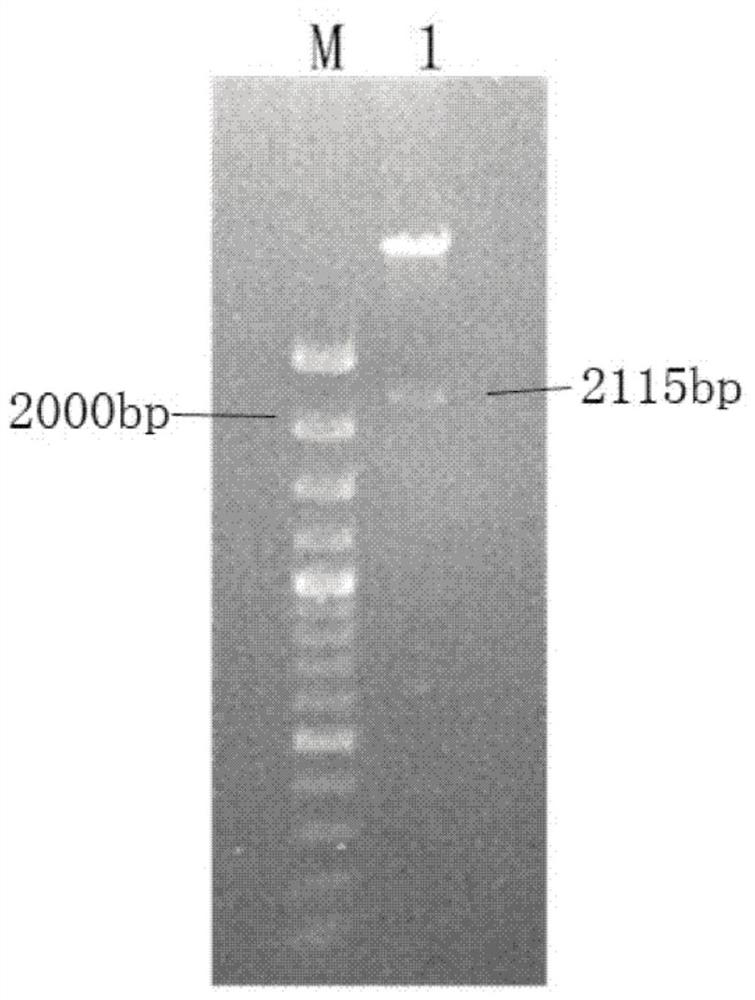Polysaccharogenic metastase MDOH gene and its application
A technology of glucosyltransferase and glycosyltransferase, applied in the direction of transferase, application, genetic engineering, etc., can solve the problems of little research and unclear relationship between the pathogenicity of bacteria with specific functions
- Summary
- Abstract
- Description
- Claims
- Application Information
AI Technical Summary
Problems solved by technology
Method used
Image
Examples
Embodiment 1
[0024] Example 1 Construction of MdoH gene (glucosyltransferase gene) deletion mutant
[0025] The Escherichia coli with the recombinant plasmid pKDMdoH obtained by integrating the upstream and downstream 200bp fragments of the MdoH gene into the pK18mobsacB plasmid was cultured overnight, the recombinant plasmid was extracted, and the electroporation competence of XooK74 was prepared, and the recombinant plasmid pKDMdoH was transferred into Xanthomonas XooK74 by electroporation In , with the help of homologous single exchange, the plasmid pKDMdoH can be integrated into the genome of XooK74, screened with Kan, Sm resistance plates, and further confirmed by simultaneous parallel spotting on sucrose plates containing Sm and Kan, Sm resistance plates single swap. Transfer the confirmed single exchangers to OB medium containing Sm, culture on a shaker at 28°C for 24 hours, and spread them on OA plates containing Sm and 10% sucrose for 3-4 days. During this process, Homologous sin...
Embodiment 2
[0026] Cloning and sequence determination of embodiment 2 MdoH gene
[0027] According to the gene sequence of MdoH, primers (AAAGGATCCGAGAACTTGTGCATCGAA (SEQ.ID.NO.3) and TTTAAGCTTCCGGTGCGAACTCAGATC (SEQ.ID.NO.4)) were designed, and the total DNA of Xanthomonas spp. Amplify the full-length sequence of the gene (95°C 10min; 95°C 30sec; 60°C 30sec; 72°C 180sec, 35 cycles; 72°C 5min) ( figure 1 ), and clone it into the cloning vector pK18mobsacB, and use the dideoxynucleotide method to determine the DNA nucleotide sequence on the ABI377 DNA automatic sequencer. The correct ModH gene sequence verified by sequencing was cloned into the prokaryotic expression vector pLAFRJ, and the recombinant plasmid pJMdoH containing the gene was obtained. source fragment ( figure 1 ).
Embodiment 3
[0028] Example 3 Verification of MdoH gene deletion mutants
[0029] Perform PCR verification on the deletion mutant DMModH, extract the total DNA of DMModH as a template, and pair with the external specific primer CMF / R (AAAGGATCCCGTCACTGCAACCGATTG (SEQ.ID.N0.5) and TTTAAGCTTTCGACCTGAGCCACCGAT (SEQ.ID.N0.6)) of the ModH gene Perform PCR verification (95°C 5min; 95°C 30sec; 60°C 30sec; 72°C 120sec, 30 cycles; 72°C 5min), the expected size of the product is 930bp, wild-type K74 total DNA template is used as a control, and the same primer is used conditions as a control, the expected size of the product is 2700bp ( figure 2 ). Using the total DNA of mutant DMModH and wild-type K74 as templates, PCR verification was carried out with specific primers IMF / R (ATCGTGCGGCTGGTCGCCGG (SEQ.ID.N0.7) and TTCTTCGTAGCTGCCCTGCA (SEQ.ID.N0.8)) within the ModH gene (95°C 5min; 95°C 30sec; 60°C 30sec; 72°C 30sec, 30 cycles; 72°C 5min), DMModH is not expected to produce a band, K74 expected pr...
PUM
| Property | Measurement | Unit |
|---|---|---|
| molecular weight | aaaaa | aaaaa |
Abstract
Description
Claims
Application Information
 Login to View More
Login to View More - R&D
- Intellectual Property
- Life Sciences
- Materials
- Tech Scout
- Unparalleled Data Quality
- Higher Quality Content
- 60% Fewer Hallucinations
Browse by: Latest US Patents, China's latest patents, Technical Efficacy Thesaurus, Application Domain, Technology Topic, Popular Technical Reports.
© 2025 PatSnap. All rights reserved.Legal|Privacy policy|Modern Slavery Act Transparency Statement|Sitemap|About US| Contact US: help@patsnap.com



